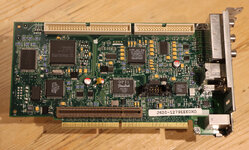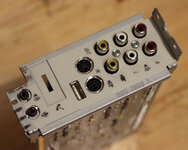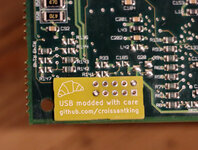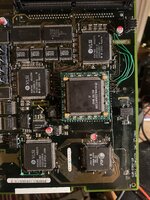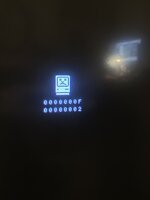You are using an out of date browser. It may not display this or other websites correctly.
You should upgrade or use an alternative browser.
You should upgrade or use an alternative browser.
croissantking's conquests
- Thread starter croissantking
- Start date
croissantking
Well-known member
Today I put back the DSP on the spare 840AV board, it has been off the board for a little while. After removal and cleanup the end result is quite an improvement. Here's a before and after:
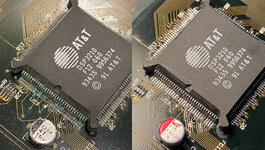
The board still does not chime, so further work is needed. There are three other fine pitched ASICs that really ought to have the same treatment, but it's such hard work. A little at a time, I think, is the way to do this.

The board still does not chime, so further work is needed. There are three other fine pitched ASICs that really ought to have the same treatment, but it's such hard work. A little at a time, I think, is the way to do this.
Last edited:
croissantking
Well-known member
I made progress on my PowerBook 180 with baked LCD. I didn’t get the alignment 100% during reassembly last time around so had a stray vertical line of black pixels.
After a couple of attempts, I got it lined up perfect and the display looks good!
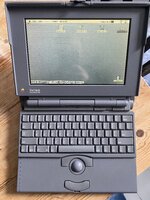
This machine is finally 100% completed - it uses the best parts of four different 160/180 series machines. It’s got a pico based SCSI emulator, 14MB RAM and a rebuilt battery pack.
The display is almost completely free of any tunnelling after a two rounds of baking. It does darken slightly after a couple of hours, but nothing like before - it’s totally usable and enjoyable for the most part.
After a couple of attempts, I got it lined up perfect and the display looks good!

This machine is finally 100% completed - it uses the best parts of four different 160/180 series machines. It’s got a pico based SCSI emulator, 14MB RAM and a rebuilt battery pack.
The display is almost completely free of any tunnelling after a two rounds of baking. It does darken slightly after a couple of hours, but nothing like before - it’s totally usable and enjoyable for the most part.
jmacz
Well-known member
I sprayed my 840AV’s 3D-printed CD-ROM bezel using Rustoleum Stone Grey which I saw that @jmacz had used for one of their projects. I was initially just going to leave it as a white resin colour, but it started to yellow in patches and looked horrible. Somehow the yellowing on the Quadra itself doesn’t bother me as much.
It’s come out a lot darker than I imagined, but it’s better than it was before at least. The shade is different enough that it looks intentional rather than a bad colour match, and it looks more premium as well.
The machine could be a candidate for either a retrobrite or a full respray, but I’m leaning towards just leaving it as-is.
View attachment 78667
I installed an auto-inject floppy (with the correct sled) that I got off eBay for cheap as untested, it works great after a full service. It had a manual insert drive in there before which wasn’t suitable for the bezel. (Side note: I love those F75W drives).
I also stuck an ATX PSU inside the case so I can actually use the computer with the case closed for the first time.
Yeah it is darker and a slightly cooler tone. I could not find a closer color without getting a custom mix done. But as you pointed out, in daylight it’s closer as the paint seems to reflect well, but at night or in a darker setting, it is definitely darker.
Hopfenholz
Well-known member
A PowerBook 180 saw me through my undergraduate degree at Bristol University 1995-98. I have a big soft spot for those macs. Used to run Corel WordPerfect which was a great piece of software.
Snial
Well-known member
It's worth explaining the baking bit a bit more, what do you do, just shove in the kitchen oven for a bit at 200ºC? Also, do you need to blind-bake it first, in case you get a soggy bottom? Will we see this on the technical round of British Bake-off at some point?The display is almost completely free of any tunnelling after a two rounds of baking. It does darken slightly after a couple of hours, but nothing like before - it’s totally usable and enjoyable for the most part.
The PB180 was stunningly expensive new in 1992, did you get it second-hand? I had a PB100 (16MHz/6MB/40MB HD) for my Postgrad in 1996-1998; though I used it mostly for transferring data + a bit of note-taking when in the Uni. For my proper work I had a PM4400 (160MHz 603e/32MB/1GB) at home and the Uni supplied me with a Sun Sparcstation IPX (40MHz MicroSparc I think/64MB/?? HD).A PowerBook 180 saw me through my undergraduate degree at Bristol University 1995-98. I have a big soft spot for those macs. Used to run Corel WordPerfect which was a great piece of software.
The PB100 wasn't that bad really. It seemed to run at the equivalent of 12MHz compared with a normal Compact Mac and of course it was very sleek for the day. I loved, it until it got stolen.
croissantking
Well-known member
It's worth explaining the baking bit a bit more, what do you do, just shove in the kitchen oven for a bit at 200ºC? Also, do you need to blind-bake it first, in case you get a soggy bottom?
I documented what I did here: link.
Essentially, it was two baking sessions - the first at 90C for 6 hours, and then 100C for 4 hours.
The polariser film gets damaged in the process, so it’s a trade off between trying to preserve it and also get rid of the tunnelling as much as possible.
Not heard of blind-baking, what’s that?
Yeah it is darker and a slightly cooler tone. I could not find a closer color without getting a custom mix done. But as you pointed out, in daylight it’s closer as the paint seems to reflect well, but at night or in a darker setting, it is definitely darker.

Here’s the colour chart for the Painter’s Touch range, what do you think about ‘Heirloom White’? It looks like it could turn out to be a good match.
Snial
Well-known member
Cool.I documented what I did here: link.
Brilliant.Essentially, it was two baking sessions - the first at 90ºC for 6 hours, and then 100ºC for 4 hours
Oh right. it looked good on the photo though!The polariser film gets damaged in the process, so it’s a trade off between trying to preserve it and also get rid of the tunnelling as much as possible
“Baking blind (sometimes called pre-baking) is the process of baking a pie crust or other pastry without the filling. Blind baking a pie crust is necessary when it will be filled with an unbaked filling (such as with pudding or cream pies), in which case the crust must be fully baked. It is also called for if the filling has a shorter bake time than the crust, in which case the crust is partly baked. Blind baking is also used to keep pie crust from becoming soggy due to a wet filling.”Not heard of blind-baking, what’s that?
No-one wants a soggy bottom.
croissantking
Well-known member
After the first bake the polariser developed lots of fine little surface cracks, and became glossier than before. Then after the second bake two of the corners had started to delaminate from the glass.Oh right. it looked good on the photo though!
The damage is very slight and not at all noticeable in normal use with the backlight on.
Agreed.No-one wants a soggy bottom.
Hopfenholz
Well-known member
2nd hand yes. Funnily enough replacing a PB100 which was a great mac too. Macs were so expensive back then, I could never have bought newIt's worth explaining the baking bit a bit more, what do you do, just shove in the kitchen oven for a bit at 200ºC? Also, do you need to blind-bake it first, in case you get a soggy bottom? Will we see this on the technical round of British Bake-off at some point?
The PB180 was stunningly expensive new in 1992, did you get it second-hand? I had a PB100 (16MHz/6MB/40MB HD) for my Postgrad in 1996-1998; though I used it mostly for transferring data + a bit of note-taking when in the Uni. For my proper work I had a PM4400 (160MHz 603e/32MB/1GB) at home and the Uni supplied me with a Sun Sparcstation IPX (40MHz MicroSparc I think/64MB/?? HD).
The PB100 wasn't that bad really. It seemed to run at the equivalent of 12MHz compared with a normal Compact Mac and of course it was very sleek for the day. I loved, it until it got stolen.
Snial
Well-known member
Indeed, my PB100 was second-hand. I bought it in May 1996, about 3 weeks before the Manchester bomb - which is relevant, because I found it in an advert in MicroMart (or Computer Shopper) for about £325 in WHSmith which was near the epicentre of the explosion. The location was basically on my way back from Manchester to Nottingham, so I just picked it up and paid with a cheque. Note to the reader: The IRA warned the authorities a bit in advance and no-one was killed (I think there were some minor injuries).2nd hand yes. Funnily enough replacing a PB100 which was a great mac too. Macs were so expensive back then, I could never have bought new
jmacz
Well-known member
I documented what I did here: link.
Essentially, it was two baking sessions - the first at 90C for 6 hours, and then 100C for 4 hours.
The polariser film gets damaged in the process, so it’s a trade off between trying to preserve it and also get rid of the tunnelling as much as possible.
Not heard of blind-baking, what’s that?
View attachment 78955
Here’s the colour chart for the Painter’s Touch range, what do you think about ‘Heirloom White’? It looks like it could turn out to be a good match.
I saw it in the store and thought it might a little too light and yellow, but worth trying as I didn't try it based on the cap color.
croissantking
Well-known member
CC_333
Well-known member
Indeed!Beautiful! Your little tag is especially clever.
It also serves as a good indicator to distinguish otherwise stock production boards which were USB-modified from genuine prototypes whose USB circuits were populated from the beginning, thus hopefully protecting at least most of the latter's collectible value and also guarding against unscrupulous sellers who might otherwise try to misrepresent these modded stock boards as prototypes in order to get a higher price.
c
croissantking
Well-known member
Woohoo!
So I got my spare 840AV board, the one with severe cap damage and battery leakage, to chime and boot after running exactly seven more bodge wires.
It has some further issues though:
-The built-in video doesn’t work - I mean, the screen comes on but nothing is displayed. So it’s sending out a sync signal but no video information, presumably? I installed a Nubus video card and this got me going.
-It doesn’t always start up. Sometimes it freezes, sometimes I get a sad Mac. Sometimes it doesn’t see the SCSI hard drive.
-It chimes but once booted there is no sound, and the audio controls are missing to adjust this.
I’ll need to check the CPU isn’t overheating since it’s got an overclocked LC040/33 fitted. And I plan to re-run the bodge wires more neatly.
So I got my spare 840AV board, the one with severe cap damage and battery leakage, to chime and boot after running exactly seven more bodge wires.
It has some further issues though:
-The built-in video doesn’t work - I mean, the screen comes on but nothing is displayed. So it’s sending out a sync signal but no video information, presumably? I installed a Nubus video card and this got me going.
-It doesn’t always start up. Sometimes it freezes, sometimes I get a sad Mac. Sometimes it doesn’t see the SCSI hard drive.
-It chimes but once booted there is no sound, and the audio controls are missing to adjust this.
I’ll need to check the CPU isn’t overheating since it’s got an overclocked LC040/33 fitted. And I plan to re-run the bodge wires more neatly.
Attachments
Well done, you have a lot more patience than I do!So I got my spare 840AV board, the one with severe cap damage and battery leakage, to chime and boot after running exactly seven more bodge wires.
croissantking
Well-known member
840AV update. So I redid some of the bodge wires next to the CPU, moving them to the backside. I wasn’t confident in how I’d done them previously, and they looked messy as well.
I popped in a 40MHz ‘040 with heatsink and set it up for a bit more testing. It’s more reliable now, it will run without crashing (still some occasional odd behaviour but much better) and sound is working too.
I honestly didn’t think I’d get this far.
I’d like to get onboard video working - any advice on that? Screen comes on but just displays all black. I’m guessing it’s a bad trace.
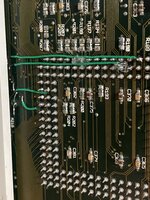
I popped in a 40MHz ‘040 with heatsink and set it up for a bit more testing. It’s more reliable now, it will run without crashing (still some occasional odd behaviour but much better) and sound is working too.
I honestly didn’t think I’d get this far.
I’d like to get onboard video working - any advice on that? Screen comes on but just displays all black. I’m guessing it’s a bad trace.

Last edited:
croissantking
Well-known member
Not a dumb question! I actually don’t, because the battery holder is missing. I have another 840AV board and I’m pretty sure the video comes on without a battery, but I’ll drop in a CR2032 battery holder today and check.Dumb question, but do you have a good battery? My Centris 610 won't display much without a battery.
Similar threads
- Replies
- 5
- Views
- 2K
- Replies
- 11
- Views
- 3K

